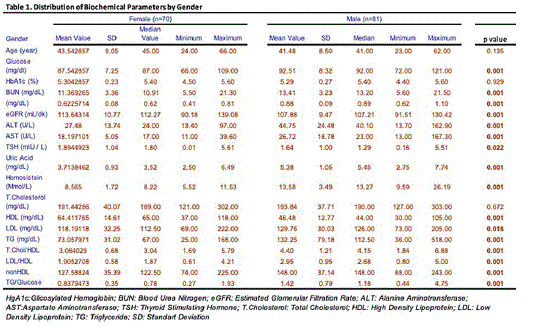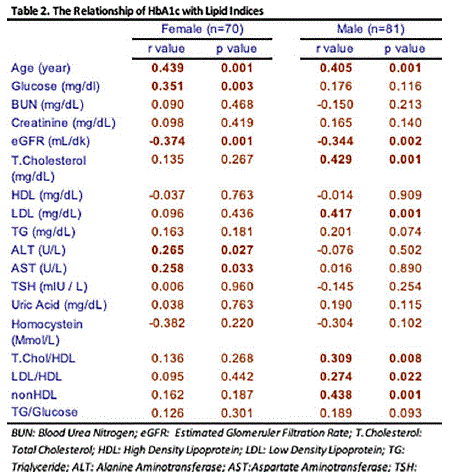ECE2023 Eposter Presentations Late Breaking (91 abstracts)
HbA1c and Lipid Profile Indices: Useful for cardiovascular risk prediction in non-diabetics?
Beyza Çiçek 1 , Yildiz Okuturlar 2 , Orhan Cem Deniz 2 , Özgür Okuturlar 3 , Ozlem Celik 4 , Mustafa Serteser 5 & Sevgi Şahin 6
1Çaldıran Devlet Hastanesi, Internal Medicine, Van, Turkey, 2Acıbadem University School of Medicine, Internal Medicine, Istanbul, Turkey, 3Özel Rami Hastanesi, Internal Medicine, Istanbul, Turkey, 4Acıbadem University School of Medicine, Endocrinology and Metabolic Diseases, Istanbul, Turkey, 5Acıbadem University School of Medicine, Clinical Biochemistry, Istanbul, Turkey, 6Acıbadem University School of Medicine, Nephrology, Istanbul, Turkey
Aims: Glycosylated hemoglobin (HbA1c) is a marker which demonstrates 3-month average level of blood glucose level. In individuals with high blood sugar level for a long time is associated with increased risk of cardiovascular disease (CVD). There is a need for simple and cost-effective markers to determine the risk of CVD in primary health care settings. In this study, we aimed to investigate the value of HbA1c for predicting cardiovascular risk in healthy non-diabetic individuals.
Method: 151 healthy individuals who applied to the check-up unit of Acıbadem University Hospital during 2017-2018 period is included in this study. The individuals who has HbA1c level 5.7 and above, and with an estimated glomerular filtration rate below 90 ml/min were excluded.
Results: There was no statistical difference between the mean age, HbA1c and total cholesterol levels of 70 female and 81 male. Though, in male subjects, fasting blood glucose, blood urea nitrogen, creatinine, alanine aminotransferase, aspartate aminotransferase, uric acid, homocysteine, low-density lipoprotein (LDL), triglyceride, non-HDL values and total cholesterol/high-density lipoprotein (HDL), LDL/HDL, triglyceride/glucose ratios were found significantly higher compared to women. In the correlation analysis performed seperately among male and female patients, there was a significant positive correlation of HbA1c in males with total cholesterol/HDL and LDL/HDL ratios.


Conclusion: HbA1c value may contribute to the follow-up of non-diabetic patients in terms of cardiovascular disease risk. In the study of Yan Li et al., it was shown that an HbA1c level higher than 5.7% in non-diabetic patients with stent implantation due to coronary artery disease leads to an increase the risk of mortality. We have seen that lipid profile indices that can be used in addition to HDL and total cholesterol values which are used to determine the 10-year risk for CVD, show a significant positive correlation with A1c in young non-diabetic male individuals. We believe that even in the early stages of coronary artery disease, HbA1c can be used for cardiovascular risk assessment in non-diabetic patients.

 }
}



